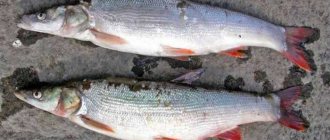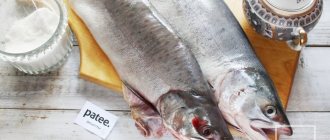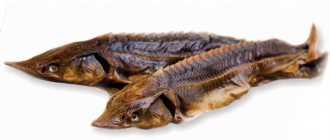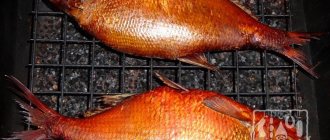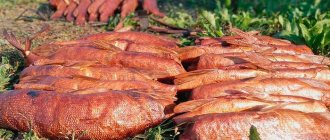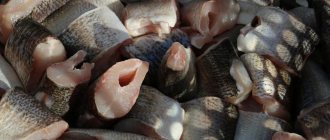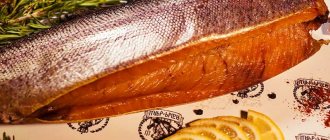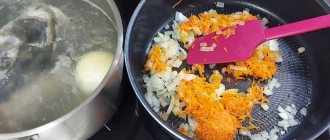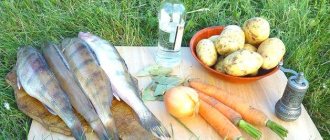Cook at home
Before considering the features of preparing fish balyk at home, it should be mentioned that this dish can be of two types:
- hanging balyk - without heat treatment,
- cold smoked, which is made over several days.
To prepare this delicacy, you need to choose the right fish.
To prepare fish balyk at home, the main product must be fresh and not frozen. It should also be noted that it is best to catch fish from a clean reservoir, ideally in the autumn. The most delicious balyk is made from salmon and pink salmon. What is the difference between these fish and others? First of all, such balyk turns out to be more aromatic and pleasant to the taste, since these fish do not smell like mud. For cooking, you can use other types of fish, the fat content of which ranges from 5 to 30%. These are:
- Sturgeon, whose weight is 2-5 kg.
- Carp weighing more than 6 kg.
- Asp, whose weight is 2-3 kg.
- Catfish, the weight of which should be from 4 kg.
- Silver carp weighing 8 kg.
- Trout that weighs from 4 to 5 kg.
- Pike perch weighing from 2.5 kg.
- Nelma about 3 kg.
- Pike weighing about 6 kg.
The quality of the dish will depend on the fat content of the fish. Balyk turns out to be very juicy and aromatic from pink salmon, sturgeon, carp, salmon, and silver carp. These types of fish have a thick layer of fat, which makes the taste simply excellent. Pike, pike perch and perch are classified as less fatty fish varieties, so it is recommended to prepare them using the dried method.

Features of cooking balyk from different fish species
For white and red fish, the process of salting and drying is practically the same. Differences may be in the set of spices and the duration of drying.
From white fish
White fish is less fatty than red fish. From a large list, the most acceptable are considered to be fleshy mackerel and carp. For a large piece of fillet, catfish, bream or asp are suitable. The balyk will be the most delicious and fatty if the fishing took place in the autumn.
Clean, cut and divide carcasses weighing 4 kg or more. When salting, you can use spices such as: laurel leaves, cloves, black peppercorns and allspice. Often this type of balyk produces the brightest and most interesting-tasting smoked fish.
From silver carp
The fibrous flesh of silver carp will glow in the sun, appetizing and rich. Required: 5 kg of silver carp, 2 bay leaves, ½ tsp. black peppercorns, 1 tbsp. l. granulated sugar, a pinch of mountain celery seeds (lovage), 5 tbsp. l. coarse salt.
The process of preparing homemade delicacies. Peel the scales and rip open the belly from the tail to the head. Scrap out the giblets, remove the eyes and cut out the gills, or better yet, cut off the entire head of the silver carp. Also cut off the thin tail section, the fin and the thin parts of the abdomen near it.
Make a cut along the back and divide the carcass into halves, removing the spinal bone. Pry the skins on the fish with a knife and remove them, pulling them towards the tail. For pickling, mix salt with sugar, broken laurel leaves, peppercorns, lovage and coriander in a container.
Pour 1/3 of the curing mass onto the bottom of the container and add one layer of washed and towel-dried silver carp onto it. Sprinkle another layer of spicy salt on top, then fillet and the rest of the salted crumbs. Place the container with the future balyk in a bag and cover it with oppression. Leave the workpiece for 6 days in the refrigerator.
Clear the slices of spices and soak in cold water for 6 hours (according to the number of days of salting), then dry. A puncture is made on the fillet and a thick thread is inserted into the hole. Fix it over a container for a day to drain the liquid. Hang the silver carp for 5 days. Divide the finished balyk into slices and serve with foamy beer. Balyk should be stored on a refrigerator shelf.
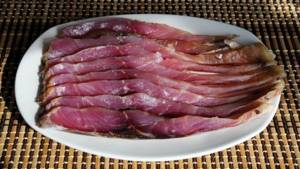
The balyk should be dried under two layers of gauze to prevent flies from landing on the flesh.
From mackerel
Mackerel is a meaty, budget-priced fish that works great when dried. For balyk you need: 3 large mackerel carcasses, 1 tbsp. l. sugar with salt, 1 tbsp. l. dry mustard powder. The process of preparing mackerel balyk looks like this.
Cut the carcasses into fillets, removing the spinal and long rib bones. Mix the salted sugar mixture with mustard and salt. Rub the resulting mixture onto the fish fillet on all sides. Place the halves in a plastic container, cover with a lid and leave on the refrigerator shelf for a day.
Next, rinse the fish with running drinking water and pat dry with a paper towel. Hang the resulting fillets in a ventilated place without bright sunlight. After a day, remove the finished balyk and place it on the refrigerator shelf for storage, wrapped in a piece of parchment.
Butchering the carcass
Before you start preparing balyk from river fish at home, you need to thoroughly clean the carcass of scales. After this, it is cleaned of all the insides and washed well under cold water. Then an incision is made along the entire spine, the loin is completely separated from the bones and divided so that you get 2 pieces of meat.
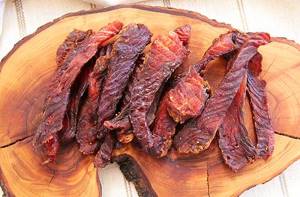
Next, the recipe for balyk at home involves cutting the carcass into portioned pieces. Take one piece of fillet and cut it lengthwise into several pieces. After this, take one of the meat strips, cut small pieces of fish with a knife, the thickness of which should be 2 cm. This is how all the meat is cut. Please note that the pieces must be without skin.
Balyk recipes
Regardless of what kind of fish is used, you can always cook balyk according to a universal recipe. This is not a classic recipe, but adapted for quick preparation of balyk. The secret of delicious balyk lies in following the principles we talked about above.
Simple recipe
We will use a recipe in which the fish is salted in brine. This is the simplest option that allows you to achieve the right taste of balyk, even if you have never cooked it. This way you can bait almost any fish. So let's get started...
What you will need:
- Fatty or medium-fat fish of medium or large size;
- Salt and sugar;
- Spices and seasonings for fish.
For one kilogram of fish you will need: salt - 150 grams, sugar - 30-50 grams. As spices, you can always use allspice and coarse black pepper, bay leaf, coriander, cloves (with caution).
Main stages:
1. Cutting fish; 2. Salting fish in brine; 3. Drying salted fish.
Preparation:
- Clean the fish from scales and remove the entrails;
- Cut off the excess - head, tail, fins;
- Cut the fish into halves along the spine;
- Remove the ridge and cut the fish into pieces 1.5-3 cm thick;
- Sprinkle the pieces of fish with a mixture of sugar and salt, add spices, mix;
- Cover the salted fish with a lid on which to place a small load;
- Place the container with fish in the refrigerator for 4-7 days for salting;
- Remove the fish from the refrigerator, rinse with cold water;
- Pour clean cold water over the fish and let it free itself from excess salt for 2-5 hours;
- Drain the water, let the remaining water drain and hang the fish to dry in a cool, dry, ventilated place, protected from the sun and insects.
After just a couple of days, the fish needs to be checked for the degree of dryness. Thin pieces of fish will be ready earlier, while larger pieces will take longer to dry.
When the degree of drying suits you, you can consider that the fish balyk is completely ready. It can be served at the table, or sent to the refrigerator for storage.
We talked in detail about how to properly store cooked fish in an article devoted to how to properly salt and dry fish.
Classic recipe
Classic balyk is made from sturgeon or fish from the salmon family. The fish is cut into balyk and tesha. If this is freshly caught fish, it will have to undergo a long salting stage for one and a half months - this is required by established standards. Thawed fish is salted much faster. See more details in the video:
Silver carp balyk
Silver carp grows to impressive sizes; it can be classified as a very large fish, which requires cutting the carcass into pieces. Silver carp balyk can be made as shown in the video below:
Balyk from carp
Like silver carp, carp grows to impressive sizes, and if you have a very large carp in your hands, you will have to cut it up in a special way.
In general, the technology for preparing balyk from carp is similar to those described above. For a diagram of cutting carp and a recipe for salting, see the following video:
Pickling
After this, you can start salting. The chopped meat is placed in a pan, covered with salt and sugar, and everything is thoroughly mixed. After this, you can take the seasoning to your taste, process the pieces, roll them into rolls, and place them in the same container. Spices that are designed specifically for fish will be ideally combined with fish, as well as khmeli-suneli seasoning and black pepper, which give the future balyk an appetizing aroma and pleasant taste.
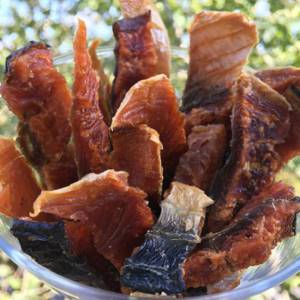
Next, at home, a recipe for balyk from asp or any other fish involves putting the semi-finished product in a pan in the refrigerator for 3-4 days. Thus, the meat is well saturated with spices and salt. During this entire time, it is recommended to stir the fish once a day. If you have a large carcass, then salting will require more time, about a week.
After this time, the container is put into the freezer for a couple of days so that all kinds of parasites and microbes die there. You can also initially freeze the fillet for several days, and then salt it.
Pickling methods
The minimum set of products for pickling is salt with sugar and spices. A variety of marinating methods provide optimal bright taste to fish of different fat contents.
Dry pickling
Salting fish using the dry method involves rubbing spices and salt into the flesh. The seasoning can be either store-bought or home-made. Mix the seasoning with coarse salt and sugar, apply to the surface and place the preparation on the refrigerator shelf.
Salting times vary depending on the fat content and size of the balyk. For lightly salted snacks, 4 days are enough, and for salted ones, a week is required. Small river carcasses are salted throughout the day.
Marinating in brine with spices
The strength of the brine is adjusted depending on the size of the carcasses. A fish weighing 1 kg will require 55 g of salt and 55 ml of water. Boil the brine separately with spices, then cool. Pour brine over the fish preparations and put them on the refrigerator shelf for 6 days. After this, soak the carcasses to remove excess salt from the fillet.
Important! If you use the dry salting method, it is necessary to press the workpiece with pressure in order to remove moisture from the meat along with harmful substances.
Drying
The last step in preparing this delicacy is drying, that is, drying the fish. It is necessary to remove the pan from the refrigerator, string the pieces onto some strong thread, while leaving a small distance between the fillets. First, it is recommended to hang the meat for several hours in the bright sun so that each part is covered with a crust. After this, the fillet should be dried in a dry and warm room where there are no insects. As a rule, the entire drying process takes from 3 to 7 days.
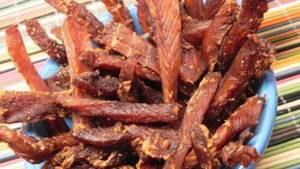
Beneficial features
Due to the fact that processing does not involve frying or boiling the fish, a large amount of useful substances and elements are retained in the meat. That is why this delicacy is very beneficial for human health. 100 g of the finished product contains the following amount of vitamins:
- 0.057 mg vitamin A.
- 2.5 mg vitamin E.
- 0.2 mg vitamin B2.
- 1.8 mg vitamin PP.
- 0.05 mg vitamin B1.

This product also contains useful minerals that are required by the human body. These include: calcium, magnesium, phosphorus, sodium, chlorine, sulfur, zinc, iron, chromium, fluorine, nickel.
In addition, fish contains saturated fatty acids, which have a beneficial effect on the appearance of the skin and hair. The composition contains small amounts of ash, cholesterol and water. That is why, if you consume this homemade delicacy, you can not only enjoy the rich taste, but also provide your body with the necessary minerals and vitamins.
Calorie content
The calorie content of 100 grams of balyk is 194 kcal. The product contains 20.4 g of protein, 12.5 g of fat and 0 g of carbohydrates. At the same time, the ratio of BJU and calorie content may vary depending on the breed of fish used, as well as on the cooking method.
This ingredient is rich in vitamins and minerals. 100 grams of fish balyk contain a huge amount of nutrients. During heat treatment, vitamins in the product are destroyed, but when salted and dried, they are preserved.
Compound:
- vitamins: A, B1, B2, E, PP;
- macroelements: sodium, calcium, potassium, selenium, magnesium;
- trace elements: iron, zinc, fluorine, molybdenum, nickel;
- cholesterol – 92 mg;
- water – 57.2 g;
- ash – 9.9 g;
- fatty acids – 2.8 g.
Balyk is a dietary food product, because it does not contain carbohydrates, but only proteins and fats. Therefore, experts recommend adding it to the menu for those who adhere to diets.
Chefs' tips
When preparing this delicacy, you can follow little tricks that will be useful to know, and then your homemade delicacy will be safe and acquire an exquisite taste:
- The duration of salting will depend on the weight of the main product. It should also be noted that in summer the salting process will take about 2 weeks, and in winter this period is 5-7 days.
- Large fish is cut into portioned pieces, the thickness of which should be no more than 2.5 cm and no less than 2 cm. If the pieces are much thinner, the meat will turn out too dry, and pieces that are too thick in the middle will not dry out.
- To prevent insects from landing on the meat, during drying it is recommended to cover it with gauze, which is soaked in vinegar beforehand.
- After drying for three days, it is best to put the fillet under pressure for a couple of hours so that each piece is smooth and shiny. After this, they are hung again for further drying.
- If you want to check the readiness of the balyk, you can press the meat with your finger. If there are no dents or moisture left on it, this indicates that the product is ready.
- Before you start salting, you should sterilize the pan; it is recommended to use plastic or enamel containers for this.
- Before treating the fillet with salt, it is also recommended to sprinkle it with a little sugar. The product that is placed in an enamel container is sprinkled only with salt.
- Any fish can be cooked in the oven. During this process, it is recommended to open the door slightly and turn on the hood. After 8 hours the dish will be ready.
- If during drying the product has absorbed some foreign odors, then it must be processed using the cold smoking method. If you want the balyk to dry faster, you can use the fan on.
- It is recommended to add black peppercorns and allspice to the salt solution. Cloves and bay leaves will add a rich taste to the delicacy.
I would also like to mention that many people do not understand the difference between salmon and pink salmon. Pink salmon belongs to the salmon family, so it can also be used to prepare balyk. So we can say that pink salmon is the same salmon.
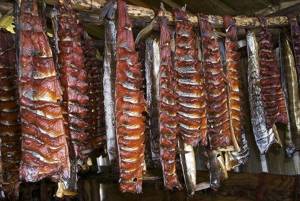
Cooking balyk
There are a huge variety of ways to prepare balyk, and there is always the possibility of improvisation, but there are also common principles that you should try to follow.
Fish balyk is divided by type of fish, size, salting method, type and degree of drying of fish meat. Cold smoked balyk (drying fish in cooled smoke) turns out to be very tasty, but it cannot be prepared at home.
Subtleties of cooking
- Large fish are flattened on the side and cut for uniform salting and drying;
- A not very large fish is flattened along the ridge without ripping open the belly, the head and tail are not removed, only the gills and entrails are removed;
- Very large fish are filleted, which is cut into pieces from which the balyk is prepared separately from the meat;
- To speed up the process of preparing balyk, the skin of the fish is removed;
- If the fish is fished in pieces, their size should be large, but in moderation - small pieces dry out quickly, and too large pieces are poorly salted;
- The taste of balyk depends not only on the salting method, but also on the degree of drying - the drier the fish meat, the saltier it is;
- The salt that is used for salting fish should be coarse without foreign impurities;
- After salting, the fish should be soaked for as many hours as the number of days it was in the brine;
- To obtain the spicy taste of balyk, at the stage of salting the fish, up to ½ part of sugar (usually 20-30%) and spicy spices (allspice, nutmeg, bay leaf, black peppercorns, coriander, cloves, ginger and others) are added to the salt. .
In general, preparing fish balyk is done as follows:
- The fish is scaled and cut;
- Prepared fish is salted dry or in brine;
- Salted fish undergoes soaking, which removes excess salt;
- The fish is hung out for drying or sent for cold smoking.
It should be noted that balyk salted in brine, in cool conditions, can remain in it for several months.
Storage Features
It is necessary to store the finished balyk in the refrigerator, having previously wrapped it in paper. It is also allowed to be placed in a special container or vacuum bag. This way the fish will stay fresh longer. The homemade delicacy should be stored for no more than 1 month, because in the future it will dry out more and lose its aroma and taste.
In most people's minds, balyk is an expensive dish, which in most cases is served at the festive table. However, preparing it at home is quite simple. It is not at all necessary to use red fish as a raw material; you can use perch, silver carp or bream.
In a slow cooker
You can prepare delicious smoked chum salmon in a slow cooker. The ideal choice for this is a device with a special function. It comes with a container for wood chips.
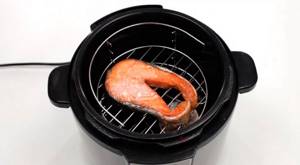
Ingredients! For 2 chum salmon steaks you need to take a pinch of salt and black pepper. Use fish seasoning to taste.
The steaks are placed on a smoking grate and placed in a prepared slow cooker with apple or alder wood chips. Place in the “Cold Smoking” mode for 35–45 minutes.
